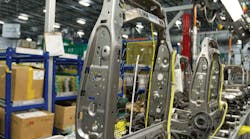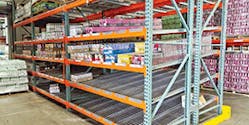Today's customers demand multiple versions of products and a greater variety, leading to a proliferating volume of SKUs that require larger pick zones and more storage space within the warehouse. On top of this, consumers are placing more frequent orders of smaller sizes and want them immediately, either delivered to their home or to another location for pick up. To keep up, distribution center (DC) operations must have ever-expanding inventories, flexible picking operations and speedier fulfillment processes.
This causes many questions to arise in the minds of warehouse managers, in regard to picking and packing orders, such as:
- What material handling equipment do I need to pick these orders correctly?
- Am I supposed to pick these orders to a pallet or container? Tote or box?
- How much labor will I need to pick to pallets or containers?
- How much room will I need to pick these orders?
- Should I use goods-to-man picking systems or man-to-goods?
- What materials do I need to keep on hand to pack orders quickly and safely?
These are just some of the many questions warehouse managers contemplate every day when picking and fulfilling customer orders. The ability to fulfill orders quickly and accurately is an essential business strategy that results in improved customer satisfaction, higher productivity and lower costs. One way to speed fulfillment is to use a carton flow solution.
Carton Flow
Most facilities use pallet racking or shelving as their storage medium. Pallet rack is a good storage option for operations that require large amounts of palletized storage. However, due to the immense loads that it must hold, pallet rack requires a lot of steel to construct, which can make it a costly product to install.
As these are static storage solutions, where product stays in its stored position, once the product in front is picked, additional picks may require reaching, bending and pulling. This adds time to the pick process and additional strain on workers. If there is less than a full pallet in the pallet rack, products must be restocked from the front picking aisle, creating a last-in-first-out (LIFO) pick rotation. The combination of restocking from the front and reaching and bending to access products in the back makes for poor space utilization.
Carton flow remedies the inefficiencies of static storage by creating a dynamic storage medium. When the front product is picked, the remaining product flows to the front, ensuring products are at their most accessible pick point in the front. This increases pick rates up to 30% versus static storage rack pick rates. Additionally it eliminates reaching, bending and pulling, producing an ergonomic safe picking process.
For most operations carton flow can be used for medium and slower moving SKUs. A good carton flow system reduces travel time by 40-80% when compared to a pick process utilizing static storage.
Picking to Pallets
Deciding whether to pick to a pallet or container can improve fulfillment rates and keep costs low, provided you use the right size pallets and containers. A wide variety of pallets exist made of different materials (wood, plastic, metal, composite) in a mixture of sizes and weights. Typically warehouse managers select pallets based on load weight and cost, but it is essential to know what type of conveyor will be used also. You need to select a conveyor with the proper structure, such as heavy-duty chains or roller conveyors that can handle the heaviest of your products.
Most pallets come in a standard size of 48"x 40"; however, custom pallet sizes are also available from different vendors. Some pallets are designed for one-way shipments; others have bottoms on them that allow for easy stacking of pallets on top of loaded ones. Racking pallets fit into open span racks, while nesting pallets have peg legs that nest together when stacked; these are suitable for small spaces.
However, storing SKUs on pallets can create a dangerous maze in the warehouse. Pallet storage rack solutions can get products off the floor to prevent tripping hazards and create a safer and more convenient pick, but you need to choose the right one for your operation. Pallet storage solutions with rollers or wheel rails are designed to optimize flow. They can be single- or double-deep and rack- or floor-mounted. Having a rear stop in the rack prevents pallets or items on the pallets from accidentally being pushed off the rack. Pallet storage racks can store more items in the same footprint, saving many businesses from having to add additional space.
Fast vs. Slow Moving Products
In a typical warehouse, approximately 80% of inventory is tied up in slow moving items, yet many of these items may be highly profitable. High-density storage can improve efficiencies of slow (and fast as well) moving items by compacting space requirements for SKUs. By combining inventory management tactics and space-saving storage equipment, slow moving items will move faster and a great amount of hidden storage space within an existing facility can be found.
In case picking, product is picked in full case or carton quantities from a variety of storage mediums: pallet positions, carton flow and shelving. For most operations, the majority of faster movers are picked from pallet positions. Medium to slow moving products are generally picked from carton flow. Slow moving products are picked from shelving. When workers pick product, they typically pick the item to a pallet, cart, or conveyor. As the picker travels the aisles selecting product, orders are grouped and sequenced for shipping.
For slow moving products, use tilted pick shelving designed to hold smaller quantities, which presents them to order pickers so they can pick product without having to reach and bend into the rack. Storing product on shelving condenses and organizes SKUs to reduce travel time and maximize space utilization.
For faster moving products, use a basic line of pallet conveyor that provides dynamic storage for pallets. Picking from a pallet is ideal for faster moving products because operators don't have to double handle the product to load the product into shelving. They simply load the entire pallet as a location on the pick line.
Ergonomics and the Pallet
In 2011 alone, approximately 3 million workplace injuries were reported by private industry employers to the U.S. Bureau of Labor Statistics. These injuries have a staggering financial impact upon the operations and facilities where the injury takes place. The National Safety Council states that the average work-related injury costs an operation $38,000 in direct costs. The more damaging figure is the indirect cost of the injury to the operation's output and consequent productivity—$150,000 on average. These costs can easily cripple an operation.
The warehouse is one area of a company where injuries abound, leading to lost productivity. Most of these injuries can be attributed to activities associated with moving products through the facility. Efforts to reduce these incidents require ergonomics, which is an applied science concerned with the design and arrangement of objects in the warehouse so that the people who interact with the items are doing so safely and efficiently.
While some warehouses are completely automated with conveyors, AS/RS and/or forklifts, many still use manual labor to handle products and pick orders. It is best if materials can be positioned so that employees can minimize reaches. When working with pallets, workers typically have to bend to reach items in the back of the shelves or pallets on the back half of a shelf, putting a strain on their back. When the worker reaches in towards the back of a shelf to pull a pallet forward, they can wrench their back, depending on the heaviness of the pallet.
Anytime workers can transfer loads horizontally from conveyors to pallets rather than by repeated lifting and bending, it means less work, speedier operations and fewer injuries. Pallet level loaders are built with heavy-duty springs and shock absorbers that lower and raise loads as boxes are added or removed from pallets. Some of these devices allow 360-degree access with a turntable design.
When moving pallets, turning a storage position from static to dynamic allows the pallet to be accessible from the aisle. Once items in the front are picked, workers can unlock a mechanical order-picking device that is affixed to the pallet and slide the back half of the pallet to the front position, moving all products to the front of the aisle. This eliminates the need for an order picker to have to reach in or crawl into a storage unit, saving the worker from unnecessary bending and pulling.
When setting up an ergonomically designed DC, it is important to select the right equipment for storing and moving equipment, while optimizing space utilization. For example, while narrow aisles may mean you can store more products, wider aisles mean employees won't have to maneuver closely around items that could fall on them or work in a cramped space.
Upgrading a DC to incorporate ergonomics involves looking at the weight of an item, the frequency that it is handled and its location in the warehouse.
Using a FIFO (first in, first out) inventory management system can help reduce the chance of obsolete inventory left sitting on warehouse shelves. In FIFO, new merchandise is stored behind older merchandise so that the older items will be picked first. In a FIFO system, loading happens from the back and picking happens in front, so you can have a continuous flow of products on shelves with a worker replenishing from the back while another worker picks from the front.
With ergonomics, not only are workers less likely to get injuries from equipment, their efficiency improves, which leads to quicker order fulfillment. By making manual handling jobs easier to perform, warehouse productivity and throughput are increased. Incorporating equipment that helps workers lift products means there is less chance of workers hurting their backs or overexerting their bodies.
Not only will ergonomics reduce liabilities, a lesser-known benefit involves lean principles. Investing in ergonomics leads to lean initiatives by eliminating waste within the warehouse—by reducing walking by bringing the goods to a person via conveyors; by removing inventory from floors by storing it properly on shelving; by delivering parts and components lineside in an assembly process; and by reducing packaging.
Brian C. Neuwirth is vice president of sales and marketing with UNEX Manufacturing, a provider of order-picking and carton flow solutions.




